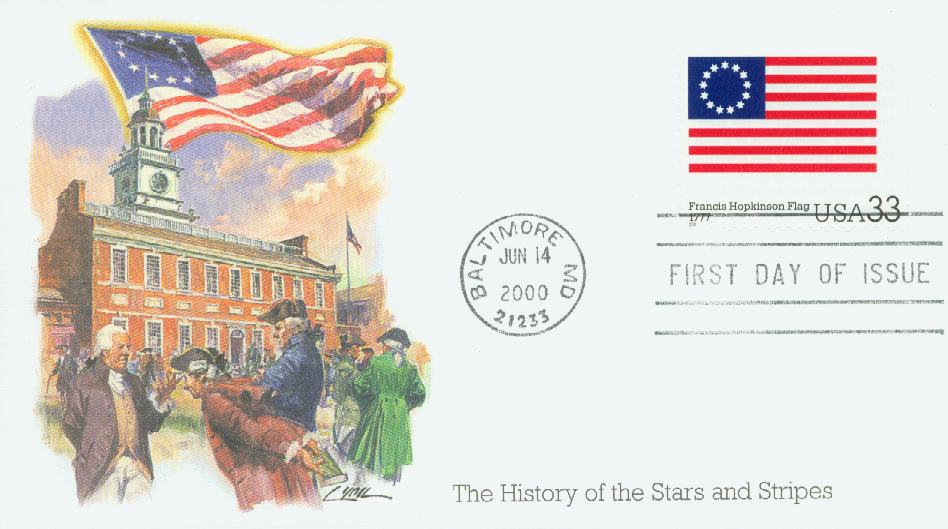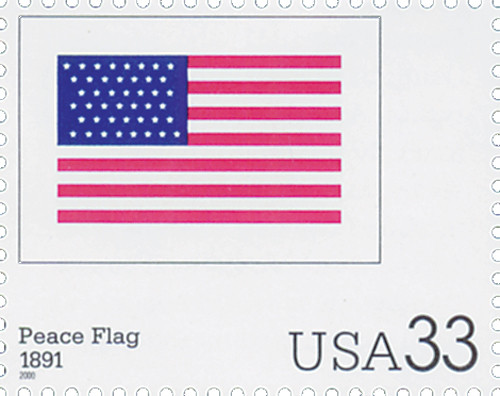
# 3403d - 2000 33c The Stars and Stripes: Continental Colors
33¢ Continental Colors (1776)
The Stars and Stripes
City: Baltimore, MD
Quantity: 4,000,000
Printed by: Banknote of America
Printing Method: Lithographed
Perforations: 10.5 x 11
Color: Multicolored
Happy Flag Day!

On June 14, 1777, Continental Congress adopted the Stars and Stripes as the flag of the United States.
The first national flag of the United States was created to represent America’s separation from the mother country. During the American Revolutionary War, George Washington designed and flew the Grand Union Flag.

Similar to the British East India Company flag of the time, the Grand Union Flag consisted of seven red and six white stripes, and the British Union symbol as the canton (the top-left rectangle where the 50 stars now rest on a blue field). The Grand Union Flag is believed to have first been flown aboard Continental Navy Commodore Esek Hopkins’ ship Alfred on the Delaware River on December 3, 1775.
When the Founding Fathers adopted the Declaration of Independence on July 4, 1776, America had no official flag, so many people designed and created their own. Legend says that seamstress Betsy Ross created the first Stars and Stripes. Members of Ross’ family have stated that she was personally hired by George Washington to create the flag from a sketch he drew. This design, one of the most famous, composes the 13 stars in a circle.

Another person, named Rebecca Young, has also been credited as a creator of the flag. Little is known of her involvement, but years later her daughter, Mary Pickersgill, would sew the Star-Spangled Banner that inspired Francis Scott Key’s song of the same name. One other potential creator was author Francis Hopkinson. He is said to have designed the flag with six-pointed stars in a staggered pattern that closely resembled the crosses of St. George and St. Andrew.
On June 14, 1777, the Second Continental Congress passed a Flag Resolution that stated, “Resolved, that the flag of the United States be thirteen stripes, alternate red and white; that the union be thirteen stars, white in a blue field, representing a new Constellation.” At the time, the Continental Congress left no historical record of why the colors red, white, and blue were chosen. Five years later, the Congress of the Confederation chose the same colors for the Great Seal of the United States. They reported the color white represented “purity and innocence,” red symbolized “hardiness and valor,” and blue signified the “vigilance, perseverance and justice.”

According to tradition, George Washington interpreted the meaning of the flag design elements differently. Washington famously said, “We take the stars from heaven, the red from our mother country, separating it by white stripes, thus showing that we have separated from her, and the white stripes shall go down to posterity representing liberty.”
The flag was not to remain as Washington saw it. Stars and stripes were added as new states entered the Union. After Vermont and Kentucky were added as states in 1791-92, the flag had a design of 15 stars and 15 stripes. This was actually the flag that inspired Francis Scott Key to write “The Defense of Fort McHenry,” which later became the “Star-Spangled Banner.” But it was apparent from the growth of America that more states would start to present problems in the flag design.

U.S. Navy Captain Samuel Reid suggested to a congressional committee that the number of stripes remain at 13, to represent the original 13 colonies, but that a star be added for each new state. President James Monroe used that suggestion when making a law in 1818 that set the standard for flag changes.
Americans’ reverence for the flag grew, and by the Civil War the first steps were taken to honor it with its own day. One of the earliest Flag Day celebrations was held on June 14, 1861, in the town of Hartford, Connecticut. A man named George Morris urged his community to celebrate America’s flag and pray for the preservation of the Union.

Another man who made Flag Day a priority was a young schoolteacher from Waubeka, Wisconsin, named Bernard J. Cigrand. On June 14, 1885, Cigrand put an American flag on his desk and told his students to write an essay about what the flag meant to them. From then on, Cigrand dedicated much of his time to establishing Flag Day around the nation, including organizing an 1894 celebration in Chicago that was attended by over 300,000 children. Flag Day soon spread across the country, and in 1916, President Woodrow Wilson proclaimed the June 14 Flag Day celebration as a national event. In 1949, President Harry S. Truman signed an Act of Congress officially making June 14 National Flag Day.
Click here for many more stamps picturing American flags.
33¢ Continental Colors (1776)
The Stars and Stripes
City: Baltimore, MD
Quantity: 4,000,000
Printed by: Banknote of America
Printing Method: Lithographed
Perforations: 10.5 x 11
Color: Multicolored
Happy Flag Day!

On June 14, 1777, Continental Congress adopted the Stars and Stripes as the flag of the United States.
The first national flag of the United States was created to represent America’s separation from the mother country. During the American Revolutionary War, George Washington designed and flew the Grand Union Flag.

Similar to the British East India Company flag of the time, the Grand Union Flag consisted of seven red and six white stripes, and the British Union symbol as the canton (the top-left rectangle where the 50 stars now rest on a blue field). The Grand Union Flag is believed to have first been flown aboard Continental Navy Commodore Esek Hopkins’ ship Alfred on the Delaware River on December 3, 1775.
When the Founding Fathers adopted the Declaration of Independence on July 4, 1776, America had no official flag, so many people designed and created their own. Legend says that seamstress Betsy Ross created the first Stars and Stripes. Members of Ross’ family have stated that she was personally hired by George Washington to create the flag from a sketch he drew. This design, one of the most famous, composes the 13 stars in a circle.

Another person, named Rebecca Young, has also been credited as a creator of the flag. Little is known of her involvement, but years later her daughter, Mary Pickersgill, would sew the Star-Spangled Banner that inspired Francis Scott Key’s song of the same name. One other potential creator was author Francis Hopkinson. He is said to have designed the flag with six-pointed stars in a staggered pattern that closely resembled the crosses of St. George and St. Andrew.
On June 14, 1777, the Second Continental Congress passed a Flag Resolution that stated, “Resolved, that the flag of the United States be thirteen stripes, alternate red and white; that the union be thirteen stars, white in a blue field, representing a new Constellation.” At the time, the Continental Congress left no historical record of why the colors red, white, and blue were chosen. Five years later, the Congress of the Confederation chose the same colors for the Great Seal of the United States. They reported the color white represented “purity and innocence,” red symbolized “hardiness and valor,” and blue signified the “vigilance, perseverance and justice.”

According to tradition, George Washington interpreted the meaning of the flag design elements differently. Washington famously said, “We take the stars from heaven, the red from our mother country, separating it by white stripes, thus showing that we have separated from her, and the white stripes shall go down to posterity representing liberty.”
The flag was not to remain as Washington saw it. Stars and stripes were added as new states entered the Union. After Vermont and Kentucky were added as states in 1791-92, the flag had a design of 15 stars and 15 stripes. This was actually the flag that inspired Francis Scott Key to write “The Defense of Fort McHenry,” which later became the “Star-Spangled Banner.” But it was apparent from the growth of America that more states would start to present problems in the flag design.

U.S. Navy Captain Samuel Reid suggested to a congressional committee that the number of stripes remain at 13, to represent the original 13 colonies, but that a star be added for each new state. President James Monroe used that suggestion when making a law in 1818 that set the standard for flag changes.
Americans’ reverence for the flag grew, and by the Civil War the first steps were taken to honor it with its own day. One of the earliest Flag Day celebrations was held on June 14, 1861, in the town of Hartford, Connecticut. A man named George Morris urged his community to celebrate America’s flag and pray for the preservation of the Union.

Another man who made Flag Day a priority was a young schoolteacher from Waubeka, Wisconsin, named Bernard J. Cigrand. On June 14, 1885, Cigrand put an American flag on his desk and told his students to write an essay about what the flag meant to them. From then on, Cigrand dedicated much of his time to establishing Flag Day around the nation, including organizing an 1894 celebration in Chicago that was attended by over 300,000 children. Flag Day soon spread across the country, and in 1916, President Woodrow Wilson proclaimed the June 14 Flag Day celebration as a national event. In 1949, President Harry S. Truman signed an Act of Congress officially making June 14 National Flag Day.
Click here for many more stamps picturing American flags.










